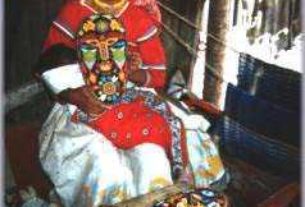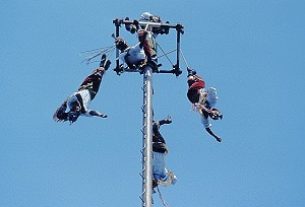Vicente Ramón Guerrero Saldaña was the second president of Mexico and the first to come from las clases populares (the “popular” classes), which in Spanish is a euphemism for an individual of peasant or working class background. This circumstance of birth is important because it would have a decisive effect on both Guerrero’s life and death. Born in Tixtla, a village in the sierra that furnishes a backdrop to Acapulco, he was of obscure origins and racially mixed background. His birth date was August 10, 1782.
When the Independence War began with Father Hidalgo’s famous grito, Guerrero was working as a gunsmith in his home town. He joined the rebellion in November 1810 and enlisted in a division that independence leader José Maria Morelos had organized to fight in the south. Guerrero distinguished himself in the battle of Izúcar, in February 1812, and had attained the rank of lieutenant colonel when the insurgents seized Oaxaca in November of the same year.
In late 1815, following the capture and execution of Morelos, Guerrero was the only major rebel leader still at large. This was the independence movement’s darkest period, similar to Washington’s ordeal at Valley Forge. But Guerrero persevered, keeping the rebellion alive through a protracted campaign of guerrilla warfare. As the movement began to revive, Guerrero won victories at Ajuchitán, Santa Fe, Tetela del Río, Huetamo, Tlalchapa and Cuautlotitlán, all communities in that southern region he knew so well.
In 1819 a poignant bit of personal drama took place. Apodaca, the Spanish viceroy, had persuaded Guerrero’s aged father to try and talk his son into surrender. Tearfully, the old man wrapped his arms around his son’s legs and begged him to accept the Viceroy’s terms. Turning to his men, Guerrero spoke these words: “Compañeros, this old man is my father. He has come to offer me rewards in the name of the Spaniards. I have always respected my father but my country comes first.” Today there is a plaque on the wall of Guerrero’s house in Tixtla containing this misquotation of his actual words: “Independence and liberty — or death! My country comes before my father.”
Failing to induce Guerrero’s surrender, Apodaca sent an army against him under the command of the flamboyant and opportunistic Agustin de Iturbide. This force left Mexico City on November 16, 1820. Guerrero, with his tactical skills and knowledge of the terrain, got the better of Iturbide in several skirmishes. Then Iturbide, true to his chameleon nature, took a step that would have the widest-ranging repercussions. On January 10, 1821, he sent Guerrero a letter proposing that the two join forces and fight for Mexican independence under what he referred to as the “three guarantees”: that Mexico should be an independent constitutional monarchy; that distinctions between Spaniards, creoles, mestizos and Indians be abolished; and that Catholicism should be the state religion.
With Guerrero’s agreement, the Three Guarantees were proclaimed in a February 21, 1821, manifesto called the Plan de Iguala. The two men combined their forces into what became known as the Trigarante Army (“Army of the Three Guarantees”) and prepared to attack Mexico City. Juan O’Donojú, who had succeeded Apodaca as viceroy, realized that the situation was hopeless and agreed to Mexican independence. On September 27, 1821, the Trigarante Army marched into the capital.
On May 21, 1822, the vainglorious Iturbide proclaimed himself Emperor Agustin 1. The coronation was sparked by a “spontaneous” demonstration on May, led by a picked band of his soldiers, that he accept an imperial crown. Though Guerrero initially supported Iturbide’s claim, by early 1823 he was in revolt against him. Iturbide was then being undermined by an even more flamboyant adventurer, Antonio López de Santa Anna. Santa Anna, posing as a defender of republican liberty, declared against Iturbide because the latter had deposed Congress when his reign began and replaced it with a council of handpicked advisers.
Guerrero and Nicolás Bravo, another independence leader, joined Santa Anna and forces led by Guerrero and Bravo defeated Iturbide’s troops at Almalonga on January 23, 1823. In March, seeing that the tide was turning against him, Iturbide abdicated and sailed into European exile.
At this time a definite liberal-conservative split was developing in Mexican politics. The liberals were known as federalists and the conservatives (who favored not less but more government) as centralists. These factions were also aligned with two wings of Masonry, the centralists favoring the Scottish rite and the federalists the York rite. A prominent York rite Mason was American minister to Mexico, Joel R. Poinsett, who soon became a bête noire among Mexican conservatives.
Following Iturbide’s abdication, Mexico adopted what was then the U.S. practice of choosing a president and vice-president from different parties. Accordingly, the president chosen in 1824 was Guadalupe Victoria, a liberal federalist, and the vice-president General Nicolás Bravo, a conservative centralist. Though Victoria served out his full four-year term, Bravo launched a rebellion against him in late 1827. The rising was defeated by Guerrero, Bravo’s old comrade-in-arms, and Bravo was sent into exile.
Bravo’s unsuccessful revolt pretty much destroyed the power of the centralists but antagonism between liberals and conservatives survived as the federalists split into two factions. In the 1928 election, Guerrero was the choice of the liberals while the conservatives rallied behind General Gómez Pedraza, a moderate, and General Anastasio Bustamante, a right-winger. Though Gómez Pedraza was declared the winner, Guerrero refused to recognize the official election result. A successful revolt in his favor was organized by Leonardo Zavala, ex-senator from Yucatán who had gained a reputation in the capital as a radical journalist. Guerrero was then duly “elected” and assumed the presidency on April 1, 1829. As a sop to the conservatives, Bustamante continued as vice-president.
Though Guerrero was a redoubtable soldier, he was out of his element in the political arena. The real power behind the throne was the ultra-liberal Zavala and, the conservatives claimed, the gringo diplomat Poinsett. In July 1829 the ambitious Santa Anna defeated an attempted Spanish invasion of Mexico, thus becoming a national hero. Though Guerrero was still too popular to become the main target of conservative attacks, they concentrated their fire on Zavala and Poinsett. This campaign was successful. Zavala, whom Guerrero had appointed as war minister, was compelled to resign in November 1829 and Poinsett to leave the country. Joined by Bravo, who had returned from exile, Bustamante mounted a revolt against Guerrero on December 4. On January 1, 1830, Bustamante assumed the presidency as Congress stripped Guerrero of his powers. Returning to his homeland in the south, Guerrero mounted an insurrection against Bustamante.
Though Bustamante’s forces suffered initial defeats, Guerrero was captured through a ruse. Bustamante’s minister of war and marine, José Antonio Facio, paid a Genoese captain fifty thousand pesos to invite Guerrero aboard his vessel, then anchored in Acapulco. Boarding the ship, Guerrero was seized and taken to the city of Oaxaca. There, after a farcical court-martial, he was executed on February 14, 1831.
Why was Guerrero treated so cruelly? Other dissidents, notably Nicolás Bravo on the right and Leonardo Zavala on the left, were either sent into exile or allowed to resign their posts. An explanation is furnished by Jan Bazant, professor of history at the Colegio de Mexico, one that paints an unpleasant picture of racism and class prejudice. Writes Bazant: “The clue is provided by Zavala who … noted that Guerrero was of mixed blood and that the opposition to his presidency came from (elites) … These people (feared) racial and social subversion. Despite his revolutionary past, the wealthy creole Bravo belonged to this ‘gentleman’s club” as did … Zavala, even with his radicalism…Guerrero’s execution was perhaps a warning to men considered as socially and ethnically inferior not to dare to dream of becoming president.”


